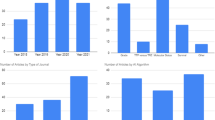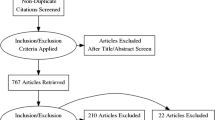Abstract
Purposes
To review the uses of AI for magnetic resonance (MR) imaging assessment of primary pediatric cancer and identify common literature topics and knowledge gaps. To assess the adherence of the existing literature to the Checklist for Artificial Intelligence in Medical Imaging (CLAIM) guidelines.
Materials and methods
A scoping literature search using MEDLINE, EMBASE and Cochrane databases was performed, including studies of > 10 subjects with a mean age of < 21 years. Relevant data were summarized into three categories based on AI application: detection, characterization, treatment and monitoring. Readers independently scored each study using CLAIM guidelines, and inter-rater reproducibility was assessed using intraclass correlation coefficients.
Results
Twenty-one studies were included. The most common AI application for pediatric cancer MR imaging was pediatric tumor diagnosis and detection (13/21 [62%] studies). The most commonly studied tumor was posterior fossa tumors (14 [67%] studies). Knowledge gaps included a lack of research in AI-driven tumor staging (0/21 [0%] studies), imaging genomics (1/21 [5%] studies), and tumor segmentation (2/21 [10%] studies). Adherence to CLAIM guidelines was moderate in primary studies, with an average (range) of 55% (34%–73%) CLAIM items reported. Adherence has improved over time based on publication year.
Conclusion
The literature surrounding AI applications of MR imaging in pediatric cancers is limited. The existing literature shows moderate adherence to CLAIM guidelines, suggesting that better adherence is required for future studies.



Similar content being viewed by others
References
Jordan MI, Mitchell TM. Machine learning: trends, perspectives, and prospects. Science. 2015;349:255–60. https://doi.org/10.1126/SCIENCE.AAA8415.
Ghahramani Z. Probabilistic machine learning and artificial intelligence. Nature. 2015;521:452–9. https://doi.org/10.1038/nature14541.
Deo RC. Machine learning in medicine. Circulation. 2015;132:1920–30. https://doi.org/10.1161/CIRCULATIONAHA.115.001593.
Liu X, Chen K, Wu T, et al. Use of multimodality imaging and artificial intelligence for diagnosis and prognosis of early stages of Alzheimer’s disease. Transl Res. 2018;194:56–67. https://doi.org/10.1016/J.TRSL.2018.01.001.
Roblot V, Giret Y, Bou Antoun M, et al. Artificial intelligence to diagnose meniscus tears on MRI. Diagn Interv Imaging. 2019;100:243–9. https://doi.org/10.1016/J.DIII.2019.02.007.
Dalmiş MU, Gubern-Mérida A, Vreemann S, et al. Artificial intelligence-based classification of breast lesions imaged with a multiparametric breast MRI protocol with ultrafast DCE-MRI, T2, and DWI. Invest Radiol. 2019;54:325–32. https://doi.org/10.1097/RLI.0000000000000544.
Ferrari R, Mancini-Terracciano C, Voena C, et al. MR-based artificial intelligence model to assess response to therapy in locally advanced rectal cancer. Eur J Radiol. 2019;118:1–9. https://doi.org/10.1016/J.EJRAD.2019.06.013.
Sung H, Ferlay J, Siegel RL, et al. Global cancer statistics 2020: GLOBOCAN estimates of incidence and mortality worldwide for 36 cancers in 185 countries. CA Cancer J Clin. 2021;71:209–49. https://doi.org/10.3322/CAAC.21660.
Bi WL, Hosny A, Schabath MB, et al. Artificial intelligence in cancer imaging: clinical challenges and applications. CA Cancer J Clin. 2019;69:127–57. https://doi.org/10.3322/CAAC.21552.
Daldrup-Link H. Artificial intelligence applications for pediatric oncology imaging. Pediatr Radiol. 2019;49:1384–90. https://doi.org/10.1007/S00247-019-04360-1.
Davendralingam N, Sebire NJ, Arthurs OJ, Shelmerdine SC. Artificial intelligence in paediatric radiology: future opportunities. Br J Radiol. 2021;94:20200975. https://doi.org/10.1259/bjr.20200975.
Otjen JP, Moore MM, Romberg EK, et al. The current and future roles of artificial intelligence in pediatric radiology. Pediatr Radiol. 2021. https://doi.org/10.1007/s00247-021-05086-9.
Martin D, Tong E, Kelly B, et al. Current perspectives of artificial intelligence in pediatric neuroradiology: an overview. Front Radiol. 2021. https://doi.org/10.3389/fradi.2021.713681.
Zheng Q, Yang L, Zeng B, et al. Artificial intelligence performance in detecting tumor metastasis from medical radiology imaging: a systematic review and meta-analysis. EClinicalMedicine. 2021. https://doi.org/10.1016/j.eclinm.2020.100669.
Freeman K, Geppert J, Stinton C, et al. Use of artificial intelligence for image analysis in breast cancer screening programmes: systematic review of test accuracy. BMJ. 2021. https://doi.org/10.1136/BMJ.N1872.
Nagendran M, Chen Y, Lovejoy CA, et al. Artificial intelligence versus clinicians: systematic review of design, reporting standards, and claims of deep learning studies. BMJ. 2020. https://doi.org/10.1136/bmj.m689.
Liu X, Faes L, Kale AU, et al. A comparison of deep learning performance against health-care professionals in detecting diseases from medical imaging: a systematic review and meta-analysis. Lancet Digit Heal. 2019;1:e271–97. https://doi.org/10.1016/S2589-7500(19)30123-2.
Mongan J, Moy L, Kahn CE. Checklist for artificial intelligence in medical imaging (CLAIM): a guide for authors and reviewers. Radiology. 2020;2:e200029. https://doi.org/10.1148/RYAI.2020200029.
Cruz Rivera S, Liu X, Chan A-W, et al. Guidelines for clinical trial protocols for interventions involving artificial intelligence: the SPIRIT-AI extension. Lancet Digit Heal. 2020;2:e549–60. https://doi.org/10.1016/S2589-7500(20)30219-3.
Cruz Rivera S, Liu X, Chan A-W, et al. Guidelines for clinical trial protocols for interventions involving artificial intelligence: the SPIRIT-AI extension. Nat Med. 2020;26:1351–63. https://doi.org/10.1038/s41591-020-1037-7.
Rivera SC, Liu X, Chan A-W, et al. Guidelines for clinical trial protocols for interventions involving artificial intelligence: the SPIRIT-AI extension. BMJ. 2020. https://doi.org/10.1136/bmj.m3210.
Liu X, Cruz Rivera S, Moher D, et al. Reporting guidelines for clinical trial reports for interventions involving artificial intelligence: the CONSORT-AI extension. Nat Med. 2020;26:1364–74. https://doi.org/10.1038/s41591-020-1034-x.
Liu X, Cruz Rivera S, Moher D, et al. Reporting guidelines for clinical trial reports for interventions involving artificial intelligence: the CONSORT-AI extension. Lancet Digit Heal. 2020;2:e537–48. https://doi.org/10.1016/S2589-7500(20)30218-1.
Liu X, Rivera SC, Moher D, et al. Reporting guidelines for clinical trial reports for interventions involving artificial intelligence: the CONSORT-AI extension. BMJ. 2020. https://doi.org/10.1136/bmj.m3164.
Tricco AC, Lillie E, Zarin W, et al. PRISMA extension for scoping reviews (PRISMA-ScR): checklist and explanation. Ann Intern Med. 2018;169:467–73. https://doi.org/10.7326/M18-0850.
Ashby D. Practical statistics for medical research. Douglas G. Altman, Chapman and Hall, London, 1991. No. of pages: 611. Price: £32.00. Stat Med. 1991;10:1635–6. https://doi.org/10.1002/SIM.4780101015.
Quon JL, Bala W, Chen LC, et al. Deep learning for pediatric posterior fossa tumor detection and classification: a multi-institutional study. Am J Neuroradiol. 2020;41:1718–25. https://doi.org/10.3174/AJNR.A6704.
Zhou H, Hu R, Tang O, et al. Automatic machine learning to differentiate pediatric posterior fossa tumors on routine MR imaging. Am J Neuroradiol. 2020;41:1279–85. https://doi.org/10.3174/AJNR.A6621.
Orphanidou-Vlachou E, Vlachos N, Davies NP, et al. Texture analysis of T1- and T2-weighted MR images and use of probabilistic neural network to discriminate posterior fossa tumours in children. NMR Biomed. 2014;27:632–9. https://doi.org/10.1002/NBM.3099.
Fernández IS, Yang E, Calvachi P, et al. Deep learning in rare disease. Detection of tubers in tuberous sclerosis complex. PLoS One. 2020;15:e0232376. https://doi.org/10.1371/JOURNAL.PONE.0232376.
Bidiwala S, Pittman T. Neural network classification of pediatric posterior fossa tumors using clinical and imaging data. Pediatr Neurosurg. 2004;40:8–15. https://doi.org/10.1159/000076571.
Fetit AE, Novak J, Peet AC, Arvanitis TN. Three-dimensional textural features of conventional MRI improve diagnostic classification of childhood brain tumours. NMR Biomed. 2015;28:1174–84. https://doi.org/10.1002/NBM.3353.
Dong J, Li L, Liang S, et al. Differentiation between ependymoma and medulloblastoma in children with radiomics approach. Acad Radiol. 2021;28:318–27. https://doi.org/10.1016/J.ACRA.2020.02.012.
Gutierrez DR, Awwad A, Meijer L, et al. Metrics and textural features of MRI diffusion to improve classification of pediatric posterior fossa tumors. Am J Neuroradiol. 2014;35:1009–15. https://doi.org/10.3174/AJNR.A3784.
Li M, Wang H, Shang Z, et al. Ependymoma and pilocytic astrocytoma: differentiation using radiomics approach based on machine learning. J Clin Neurosci. 2020;78:175–80. https://doi.org/10.1016/J.JOCN.2020.04.080.
Zarinabad N, Abernethy LJ, Avula S, et al. Application of pattern recognition techniques for classification of pediatric brain tumors by in vivo 3T 1H-MR spectroscopy—a multi-center study. Magn Reson Med. 2018;79:2359–66. https://doi.org/10.1002/MRM.26837.
Parham DM, Barr FG. Classification of rhabdomyosarcoma and its molecular basis. Adv Anat Pathol. 2013;20:387–97. https://doi.org/10.1097/PAP.0B013E3182A92D0D.
Banerjee I, Crawley A, Bhethanabotla M, et al. Transfer learning on fused multiparametric MR images for classifying histopathological subtypes of rhabdomyosarcoma. Comput Med Imaging Graph. 2018;65:167–75. https://doi.org/10.1016/J.COMPMEDIMAG.2017.05.002.
Artzi M, Gershov S, Ben-Sira L, et al. Automatic segmentation, classification, and follow-up of optic pathway gliomas using deep learning and fuzzy c-means clustering based on MRI. Med Phys. 2020;47:5693–701. https://doi.org/10.1002/MP.14489.
Iv M, Zhou M, Shpanskaya K, et al. MR imaging-based radiomic signatures of distinct molecular subgroups of medulloblastoma. Am J Neuroradiol. 2019;40:154–61. https://doi.org/10.3174/AJNR.A5899.
Huang B, Law MW-M, Khong P-L. Whole-body PET/CT scanning: estimation of radiation dose and cancer risk. Radiology. 2009;251:166–74. https://doi.org/10.1148/radiol.2511081300.
Wang Y-R, Baratto L, Hawk KE, et al. Artificial intelligence enables whole-body positron emission tomography scans with minimal radiation exposure. Eur J Nucl Med Mol Imaging. 2021;489(48):2771–81. https://doi.org/10.1007/S00259-021-05197-3.
Florkow MC, Guerreiro F, Zijlstra F, et al. Deep learning-enabled MRI-only photon and proton therapy treatment planning for paediatric abdominal tumours. Radiother Oncol. 2020;153:220–7. https://doi.org/10.1016/J.RADONC.2020.09.056.
Maspero M, Bentvelzen LG, Savenije MHF, et al. Deep learning-based synthetic CT generation for paediatric brain MR-only photon and proton radiotherapy. Radiother Oncol. 2020;153:197–204. https://doi.org/10.1016/J.RADONC.2020.09.029.
Udaka YT, Packer RJ. Pediatric brain tumors. Neurol Clin. 2018;36:533–56. https://doi.org/10.1016/J.NCL.2018.04.009.
Mukherkjee D, Saha P, Kaplun D, et al. Brain tumor image generation using an aggregation of GAN models with style transfer. Sci Rep. 2022;12:9141. https://doi.org/10.1038/s41598-022-12646-y.
Gupta RK, Bharti S, Kunhare N, et al. Brain tumor detection and classification using cycle generative adversarial networks. Interdiscip Sci Comput Life Sci. 2022;14:485–502. https://doi.org/10.1007/s12539-022-00502-6.
Ardalan Z, Subbian V. Transfer learning approaches for neuroimaging analysis: a scoping review. Front Artif Intell. 2022. https://doi.org/10.3389/frai.2022.780405.
Xu J, Glicksberg BS, Su C, et al. Federated learning for healthcare informatics. J Healthc Informatics Res. 2021;5:1–19. https://doi.org/10.1007/s41666-020-00082-4.
Plana A, Furner B, Palese M, et al. Pediatric cancer data commons: federating and democratizing data for childhood cancer research. JCO Clin Cancer Inform. 2021. https://doi.org/10.1200/CCI.21.00075.
Prager R, Bowdridge J, Kareemi H, et al. Adherence to the standards for reporting of diagnostic accuracy (STARD) 2015 guidelines in acute point-of-care ultrasound research. JAMA Netw Open. 2020;3:e203871–e203871. https://doi.org/10.1001/JAMANETWORKOPEN.2020.3871.
Hong PJ, Korevaar DA, McGrath TA, et al. Reporting of imaging diagnostic accuracy studies with focus on MRI subgroup: adherence to STARD 2015. J Magn Reson Imaging. 2018;47:523–44. https://doi.org/10.1002/JMRI.25797.
Thiessen M, Vogel JA, Byyny RL, et al. Emergency ultrasound literature and adherence to standards for reporting of diagnostic accuracy criteria. J Emerg Med. 2020;58:636–46. https://doi.org/10.1016/J.JEMERMED.2019.09.029.
Korevaar DA, Wang J, van Enst WA, et al. Reporting diagnostic accuracy studies: some improvements after 10 years of STARD. Radiology. 2015;274:781–9. https://doi.org/10.1148/radiol.14141160.
Funding
This work was partially supported by the Samuel Lunenfeld Summer Studentship Award 2021 (project ID: 6120100197), and by The Terry Fox New Frontiers Program Project Grant in Early Detection and Prevention of Li-Fraumeni Syndrome (2018–2023).
Author information
Authors and Affiliations
Contributions
Study concepts, BT, AG, MST, and ASD; Literature research: BT, AG, MST, and ASD; Data analysis and interpretation: BT, AG, MST, and ASD; Manuscript drafting BT, and ASD; Manuscript editing and revisions, all authors; Final approval of the manuscript: all authors.
Corresponding author
Ethics declarations
Conflict of interest
The authors declare no competing interests.
Additional information
Publisher's Note
Springer Nature remains neutral with regard to jurisdictional claims in published maps and institutional affiliations.
Supplementary Information
Below is the link to the electronic supplementary material.
About this article
Cite this article
Tsang, B., Gupta, A., Takahashi, M.S. et al. Applications of artificial intelligence in magnetic resonance imaging of primary pediatric cancers: a scoping review and CLAIM score assessment. Jpn J Radiol 41, 1127–1147 (2023). https://doi.org/10.1007/s11604-023-01437-8
Received:
Accepted:
Published:
Issue Date:
DOI: https://doi.org/10.1007/s11604-023-01437-8




